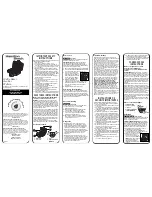
20
DELAYED START PROGRAMME
You can programme the appliance up to start 15 hours in advance to have your prepara-
tion ready at the time you want. This function cannot be used on programmes 5,6,7,9,10.
This step comes after selecting the programme, browning level and weight. The programme time is dis-
played. Calculate the time difference between the moment when you start the programme and the time at
which you want your preparation to be ready.
The machine automatically includes the duration of the programme cycles.
Using the and buttons, display the calculated time ( up and down).
Short presses change the time by intervals of 10 min + a short beep.
Holding the button down gives continuous scrolling of 10-min intervals.
For example, it is 8 pm and you want your bread to be ready for 7 am the next morning. Programme 11:00
using the and buttons.
Press the button. A beep is emitted. The facing indicator light switches on and the timer colon
:
blinks. The countdown begins. The ON light switches on.
If you make a mistake or want to change the time setting, hold down the button until it makes a beep.
The default time is displayed. Start the operation again.
With the delayed start programme do not use recipes which contain fresh milk, eggs, soured cream,
yoghurt, cheese or fresh fruit as they could spoil or stale overnight.
PRACTICAL ADVICE
If there is a power cut:
if, during the cycle, the programme is interrupted by a power cut or
mishandling, the machine has a 7-min protection time during which the settings are saved. The cycle
starts again where it stopped. Beyond that time, the settings are lost.
If you plan to run a second programme bake a second loaf,
open the lid and wait 1 hour
before beginning the second preparation.
INGREDIENTS
Fats and oils:
fats make the bread softer and tastier. It also stores better and longer. Too much fat
slows down rising. If you use butter, cut it into tiny pieces so that it is distributed evenly throughout the
preparation, or soften it. You can substitute 15g butter for 1 tablespoon of oil. Do not add hot butter. Keep
the fat from coming into contact with the yeast, as fat can prevent yeast from rehydrating. Do not use
low fat spreads or butter substitutes.
Eggs:
eggs make the dough richer, improve the colour of the bread and encourage the development of
the soft, white part. If you use eggs, reduce the quantity of liquid you use proportionally. Break the egg and
top up with the liquid until you reach the quantity of liquid indicated in the recipe. Recipes are designed for
one 50 g size egg; if your eggs are bigger, add a little flour; if they are smaller, use less flour.
Milk:
recipes use either fresh or powdered milk. If using powdered milk, add the quantity of water stated
in the recipe. It enhances the flavour and improves the keeping qualities of the bread. For recipes using
fresh milk, you can substitute some of it with water but the total volume must equal the quantity stated in
the recipe. Semi-skimmed or skimmed milk is best to avoid bread having a close texture. Milk also has an
emulsifying effect which evens out its airiness, giving the soft, white part a better aspect.
Water:
water rehydrates and activates the yeast. It also hydrates the starch in the flour and helps the
soft, white part to form. Water can be totally or partially replaced with milk or other liquids. Use liquids at
room temperature.
Flour:
the weight of the flour varies significantly depending on the type of flour used. Depending on the
quality of the flour, baking results may also vary. Keep flour in a hermetically sealed container, as flour
reacts to fluctuations in atmospheric conditions, absorbing moisture or losing it. Use “strong flour”, “bread
flour” or “baker’s flour” rather than standard flour.
OW3000 MOULI ref 3313488 19/07/06 14:26 Page 21































